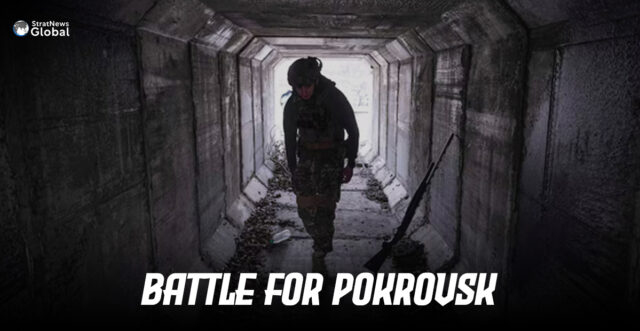After months of holding off a larger Russian force around Pokrovsk with bomb-laden drones, Ukraine now faces advancing Russian troops who, amid a summer offensive exploiting defensive gaps, entered the city for the first time last week, according to geolocated footage from Ukrainian and Russian Telegram channels verified by Reuters.
Ukrainian soldiers’ success in stopping their enemy from taking Pokrovsk since last year has long thwarted one of Moscow’s central military goals, although the city itself is heavily damaged and all but a few hundred of the 60,000-strong population have fled.
Pokrovsk sits atop large coking coal reserves and, until Russian forces moved closer, was important to Ukraine’s military supply lines in the country’s east.
Reuters spoke to more than a dozen sources, including Ukrainian soldiers and relatives of Russian soldiers missing in action around the city, and made two trips to the area over four months to examine the shifting tactics in the key theatre of the eastern front.
The Pokrovsk front is the most active in the war, with 111,000 Russian soldiers amassed there for the summer offensive, Ukrainian top military commander Oleksandr Syrskyi has said.
Russia’s Prime Target
Russia’s forces initially aimed to seize Pokrovsk early last year, first with frontal assaults and later trying to encircle the city, which Russia calls by the Soviet-era name Krasnoarmeysk, or Red Army town.
Ukraine slowed the advance this spring by deploying experienced units, laying minefields and other defensive barriers, while harassing Russian forces with large numbers of drones, said Viktor Trehubov, spokesperson for the military administration that covers Pokrovsk.
“They didn’t stop trying to advance, but we were repelling them well,” said an artillery unit soldier who goes by call sign Vogak and serves on the Pokrovsk front.
Since then, Moscow’s forces have picked up the pace, adapting and expanding the use of drones in their own arsenal.
Russia has built on the lessons used in pushing Ukrainian forces out of its Kursk region, where it first scaled the use of fibre-optic cable drones that cannot be stopped by the electronic jammers both sides used to confuse regular radio-controlled drones, analyst Michael Kofman said.
The spools of hair-like cable give them enough range that Russia can threaten Ukraine’s forces and logistics 25 kilometres behind the front line. Russia has more of the fibre-optic drones than Ukraine, giving them an advantage, said Roman Pohorilyi, the founder of the Ukrainian open-source research group DeepState.
The advances accelerated after Russia took control of a highway in May that connects Pokrovsk to Kostiantynivka, another of Ukraine’s ‘fortress cities’ in the east, a map generated by DeepState shows.
One of the main roads to the city is covered by nets to protect vehicles from Russian drone strikes. Serhii Dobriak, the head of the local military administration, last week said it was increasingly hard to deliver food to the city and that grocery stores would have to close in the coming days.
While faster than before, Russia’s territorial gains remain minor, with only 5,000 square kilometres (1,930 square miles) of Ukraine taken since the start of last year, less than 1% of the country’s overall territory, according to a June report from the Centre for Strategic and International Studies, a Washington-based think tank.
In total, Russia has occupied around a fifth of Ukraine.
Ukrainian President Volodymyr Zelenskyy said the entry of small groups of Russian troops into Pokrovsk was insignificant and that they were “all destroyed” by Ukraine’s soldiers.
Russia’s Defence Ministry did not respond to detailed requests for comment for this story.
At What Cost?
Serhii Filimonov, commander of a Ukrainian military battalion called “Da Vinci Wolves,” which operates around Pokrovsk, saw firsthand how Russia’s glacial advance on the city over the past year cost it heavily in killed and injured soldiers in the first half of 2025.
Russian soldiers tried to advance by stealth but were hounded by Ukrainian soldiers flying small quadcopter drones mounted with cameras and explosives, he said.
“Every prisoner says drones are the thing they are most afraid of, the thing that constantly kills them, and the things they see when they sleep, the nightmares they have,” Filimonov told Reuters in an interview in April, citing debriefs of Russian soldiers captured by his men.
Filimonov said groups of attackers were given a phone with a location pinned on a map, and told to head towards it. If the first group was killed, another one was sent to replace them, he said, citing the debriefs. Reuters was unable to independently verify his account.
The Russians operated in raiding parties of around a half a dozen, often advancing on foot because large vehicles are an easy target for drone pilots, Filimonov and Trehubov said.
Some left their vehicles as far as nine miles (15 km) from the front line and walked the rest of the way to be less visible to drone operators, Filimonov said. Others have taken to motorbikes to outpace the aircraft, piloted by Ukrainian soldiers often wearing virtual reality-style goggles attached to a drone’s camera, offering a first-person view of the route and target, Trehubov said.
The Ukrainian resistance in and around Pokrovsk has blocked Russia’s ambition of taking the remaining parts of Ukraine’s Donetsk region, one of President Vladimir Putin’s principal war aims.
Although its significance to Ukraine as a military supply centre has already faded, Kyiv-based military analyst Serhii Kuzan said Pokrovsk’s fall could free up Russian troops and open the door to more Russian advances in the region.
More than a million Russian soldiers have been killed or wounded since the invasion of Ukraine in February 2022, almost a quarter of those since the start of this year, according to British military intelligence estimates.
Reuters could not verify these numbers.
Neither Ukraine nor Russia gives official data on their own personnel losses.
($1 = 79.4000 roubles)
(With inputs from Reuters)





